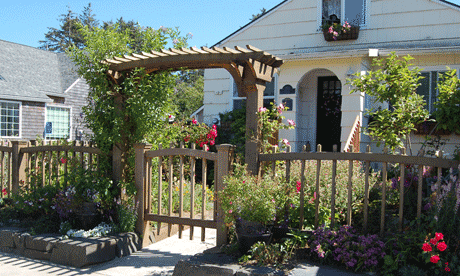|
History and Style of Garden Arbors With Gates
Since the dawn of cultivated gardening, we have searched for ways to emphasize garden highlights and delineate the garden spaces. Over the years, garden arbors have become the premium tools to accomplish these ends in garden design. Whether you’re intending to construct a garden border, front yard entrance, freestanding arch, garden corridor, or a plant-climbing structure; the garden arbor can be modified to cover your landscaping requirements. Garden arbors are considered to be structural supports. They come in a variety of dimensions of height, width and depth. They are usually constructed using a double-side design but can sometimes contain three sides. Arbors are often constructed with a latticework or ladder slat design and may have arched, peaked or flat roofing. Sometimes they contain additional support slats. Garden arbors with gates can be used as an archway entrance to a garden. It can also be used as a wall for vines or other climbing plants, such as wisteria, honeysuckle and roses, to weave and wend their way through and around. An arbor can be used as an overhead cover for a bench in a smaller garden, or it can act as a divider in a larger garden setting. You can also find garden arbors that provide support for bench swings. An arbor with a gate can provide a dreamy entry to your garden. Garden arbors are not particular to any one culture, and the varied designs conform to their ethnic environments. Red cedar is the classic material for building arbors in North America, but arbors are also made out of vinyl, wire, stone, bentwood and other materials. Throughout history, garden arbors have been made from varying materials. In the gardens of medieval England arbors were made from stone. In ancient and modern Greece and other places such as North Africa and Turkey, arbors can be found built from adobe and plaster. Gardeners and landscapers in France, Spain Portugal and many other places used wrought iron and other metals. Landscapers in India, Japan and China predominately used wood in the construction of their arbors. In the modern world of synthetics, plastic is often used for arbors; however plastic has less structural integrity and cannot withstand the load bearing capacity that is required for such plants as grapes and roses. Wood is a classic choice for arbor construction because plants thrive on its porous surface, which provides them easy gain to water that the wood has absorbed. Metal and stone arbors last through the ages, but they need to be anchored in cement and are not as easily constructed, and they often require craftsman to assemble them. For information on garden arbors without gates, please read these articles:
|
|
|||||||||||||||
|
|||||||||||||||||
|
|
|||||||||||||||||


